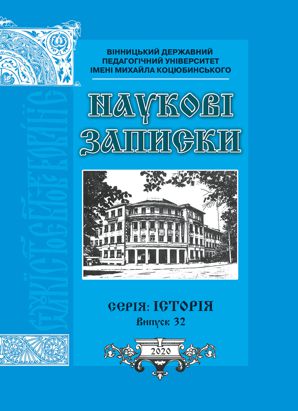Abstract
The purpose of the article is to highlight the aspirations of the Soviet authorities to explore teachers in Podillia in the anti-religious propaganda in the early 1920's. The methodology of the study is based on the principles of historicism, science, objectivity, systematic, social approach, the use of the general methods (description, generalization, systematization, analysis) and the special-historical ones (historical-comparative, structural-functional, concrete-sociological). The scientific novelty is that the place and the role of a separate category of the population of the Soviet society were determined on the basis of archival materials. They were educators in the anti-religious campaign of the early 20s of the 20th century in Podillia. The reasons for forcing the Communist leadership to active educators engaging in opposing the church movement are revealed. Conclusions. Despite the anti-church campaign intensification, the establishment of atheism on the territory of Podillia the believers activity raises. A striking manifestation of the population devoutness was the appearance of the so-called miracles and mass worship to the places where they had occured. The well-known miracles of that time were: the Kalyniv Cross, the appearance of the God’s Mother in the Jehoshaphat valley, the mass renewal of icons, the appearance of crosses and others. The miracles spread rapidly throughout the region, and the pilgrimage spread to the places where the miracles had occurred. The intensification of the church movement and the formation of an appropriate mood among the population disturbed the Soviet authorities greatly. One form of the state confrontation to this phenomenon was the creation of special commissions that had to disclose the facts of the miracles. The educators of Podillia were actively enlisted in the commissions work, they performed explanatory work, participated in various meetings, societies, conferences. Ideologically conscious teachers prepared reports about the Earth origin, the appearance of a man, the emergence of religions. The teachers of Physics and Chemistry were involved in the impugnment of the miracles existence through performing the experiments. The work of Podillia’s educators became an effective support for the party organs in the struggle against the religious movement in the early 1920s.
References
Бабенко, Л. Л. (2013). Взаємодія партійно-радянських органів та місцевих апаратів держбезпеки в боротьбі з «релігійними чудесами» (1920-ті – 1940 ві pp.). З архівів ВУЧК-ГПУ-НКВД-КГБ,1, 327-350.
Галамай, О. М. (2002). Релігійні чудеса на Вінниччині. Вінниччина: історія та сучасність. Вінниця, 50–54.
ДАВіО – Державний архів Вінницької області.
Дмитрук, Н. (1925). Про чудеса на Україні року 1923-го. Етнографічний вісник, 1, 50-65.
Дровозюк, С. І. (2002) Масовий релігійний рух в Україні у 20-х рр. ХХ ст.: історіографія проблеми. Наукові записки Вінницького державного педагогічного університету імені Михайла Коцюбинського. Серія: Історія, 4, 247-253.
Дровозюк, С. І. (2005.) Національно-культурне та духовне життя українського селянства у 20 – 30-х рр. ХХ століття: історичний нарис. Вінниця, 364 с.
Дяків, В. М. (2010). Прояви релігійності українців в умовах більшовицької окупації початку 1920-х років. Вісник Львівського університету. Серія: Філологія, 43, 169-180.
Завальнюк, К., Стецюк, Т. (2007) Релігійні “чудеса” на Поділлі (20-ті роки XX століття). Ред. колегія: З. Білик, Я. Дашкевич, Л. Моравська, Історія релігій в Україні. Науковий щорічник, (409- 419). Львів: Видавництво Львівського музею історії релігії «Логос».
Кравченко, В. (1927) «Псальми», що в 1923-24 рр. співали прочани під час подорожувань до різних чудес. Етнографічний вісник, 4, 71-78.
Олійник, М. П. (2013). Прояви чудес та оновлення ікон на Поділлі в 1923 р. та боротьба влади з цим явищем. Освіта, наука і культура на Поділлі, (20), 509-519.
Панасюк, М. П. (2019). Релігійна творчість подолян в 1920-х рр.. Наукові записки Тернопільського національного педагогічного університету імені Володимира Гнатюка. Серія: Історія, 2, 123-127.
Пчілка, О. (1925). Українські народні легенди останнього часу. Етнографічний вісник. 1, 41-49.
Стадник, О. & Кузьмінець, Н. (2020). Релігійне життя подільського села у вимірах радянської повсякденності 20-х рр.. ХХ ст. Наукові записки Вінницького державного педагогічного університету імені Михайла Коцюбинського. Серія: Історія, 31, 79-87. https://doi.org/10.31652/2411-2143-2019-31-79-87

This work is licensed under a Creative Commons Attribution 4.0 International License.
Copyright (c) 2020 Scientific Papers of the Vinnytsia Mykhailo Kotsiubynskyi State Pedagogical University. Series: History





